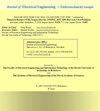Graph based anomaly detection in human action video sequence
IF 1.2
4区 工程技术
Q4 ENGINEERING, ELECTRICAL & ELECTRONIC
Journal of Electrical Engineering-elektrotechnicky Casopis
Pub Date : 2022-09-01
DOI:10.2478/jee-2022-0042
引用次数: 0
Abstract
Abstract In our paper, we have proposed to use graphs to detect anomaly in human action video. Although the detection of anomaly is a widely researched topic, but very few researchers have detected anomaly in action video using graphs. in our proposed method we have represented the smaller section (sub-section) of our input video as a graph where vertices of the graph are the space time interest points in the sub-section video and the association between the space time interest points exists. Thus, graphs for each sub section are created to look for a repeated substructure. We believe most of the actions inherently are repeated in nature. Thus, we have tried to capture the repetitive sub-structure of the action represented as a graph and used this repetitive sub-structure to compress the graph. If the compressed graph has few elements that have not been compressed, we suspect them as anomaly. But the threshold value takes care not to make the proposed method very much sensitive towards the few uncompressed elements. Our proposed method has been implemented on locally created “extended KTH” and “extended Weizmann” datasets with good accuracy score. The proposed method can also be extended for few more applications such as training athletes and taking elderly care.基于图的人类动作视频序列异常检测
在本文中,我们提出了使用图形来检测人体动作视频中的异常。虽然异常检测是一个被广泛研究的课题,但是很少有研究者利用图形来检测动作视频中的异常。在我们提出的方法中,我们将输入视频的较小部分(子部分)表示为一个图,其中图的顶点是子部分视频中的时空兴趣点,并且时空兴趣点之间存在关联。因此,为每个子部分创建图形来寻找重复的子结构。我们相信大多数行为本质上是重复的。因此,我们试图捕捉动作的重复子结构,用图表示,并使用这个重复的子结构来压缩图。如果压缩图中没有被压缩的元素很少,我们就怀疑它们是异常的。但是,阈值要注意不使所提出的方法对少数未压缩元素非常敏感。我们提出的方法已经在本地创建的“扩展KTH”和“扩展Weizmann”数据集上实现,并取得了良好的精度分数。该方法还可以推广到运动员训练和老年人护理等应用领域。
本文章由计算机程序翻译,如有差异,请以英文原文为准。
求助全文
约1分钟内获得全文
求助全文
来源期刊
CiteScore
1.70
自引率
12.50%
发文量
40
审稿时长
6-12 weeks
期刊介绍:
The joint publication of the Slovak University of Technology, Faculty of Electrical Engineering and Information Technology, and of the Slovak Academy of Sciences, Institute of Electrical Engineering, is a wide-scope journal published bimonthly and comprising.
-Automation and Control-
Computer Engineering-
Electronics and Microelectronics-
Electro-physics and Electromagnetism-
Material Science-
Measurement and Metrology-
Power Engineering and Energy Conversion-
Signal Processing and Telecommunications

 求助内容:
求助内容: 应助结果提醒方式:
应助结果提醒方式:


